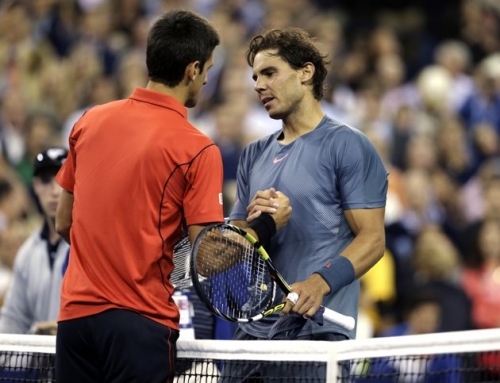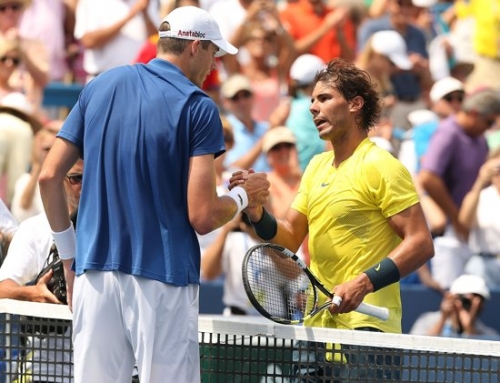 While September 11, 2001 is something indelibly inked in the minds and hearts of Americans, it also happened shortly after the conclusion of the 2001 US Open. On September 9, 2001, Pete Sampras was still looking for his elusive 14th Slam. He had had chances the year before. On his way to the 2000 finals, Sampras played Hewitt, beat him in the semifinals, only to lose to the mercurial Marat Safin. That win, more than any other signaled the beginning of the end of the Sampras/Agassi era which lasted through the 1990s and marked the second coming of American tennis after the heights of McEnroe and Connors.
While September 11, 2001 is something indelibly inked in the minds and hearts of Americans, it also happened shortly after the conclusion of the 2001 US Open. On September 9, 2001, Pete Sampras was still looking for his elusive 14th Slam. He had had chances the year before. On his way to the 2000 finals, Sampras played Hewitt, beat him in the semifinals, only to lose to the mercurial Marat Safin. That win, more than any other signaled the beginning of the end of the Sampras/Agassi era which lasted through the 1990s and marked the second coming of American tennis after the heights of McEnroe and Connors.
In 2001, the story was different. Sampras beat the player that beat him in 2000, namely, Marat Safin in the semifinals, but faced Lleyton Hewitt in the finals, and after a tight first set, Hewitt won the next two sets in lopsided fashion. Hewitt had stayed around until Monday as is traditional to get some more photos, but was on a plane to Australia later that day.
A decade later, September 11, 2011 would fall on Sunday. This would have been the men’s final, and it seemed, for a time, that the US Open execs really, really wanted the match to be played on Sunday despite the remnants of Hurricane Lee washing out tournament play on Tuesday and Wednesday. With the prospect of one of the finalist, in particular, Rafael Nadal, having to play four matches in four days, the powers-that-be decided to shift the men’s final to Monday afternoon, just as it has been scheduled the last 3 years due to the rains that have affected the tournament each of the last 4 years. A 4 PM final is a disaster for ratings. Americans are at work on the East Coast, and therefore at work on the West Coast too. It would be nice to schedule it at 8 PM for prime-time viewing, but with football season in full gear, the ratings would likely be poor as well.
Sometimes sports events go on, and it doesn’t meld cleanly with the remembrance of a national tragedy. It’s been a few years since an American has won the US Open or even been in the finals. We have Andy Roddick to thank for that. Instead, the tournament has concluded with the two best players, at least in the rankings, meet once again.
So what will happen?
Novak Djokovic is going to be favored even if like last year, he needed a bit of luck. Djokovic was facing his second loss of the year to Roger Federer. Down 5-3, 40-15 Djokovic took a relatively slow wide serve and hit it as hard as he could. The return was like a laser to the sideline. Roger Federer couldn’t believe it. What kind of serious tennis player hits an all-or-nothing shot like that? To him, it was unthinkable, and this one act of desperation seemed to rattle his calm. Roger Federer would serve the next point into Djokovic’s body and Djokovic would fight off this serve. Federer swooped on this shot, hit an inside-out forehand that clipped the net and fell out.
Federer had been so focused for this set. The erratic play that caused him to lose sets 3 and 4 was being held at bay. But once Djokovic escaped match points, his confidence soared and Federer’s dived. Federer’s face wouldn’t show how he felt, but all of a sudden, Federer was thinking “How can this be happening once again?”. And he would lose serve twice and Djokovic would be the one heading to the finals once again.
Djokovic hasn’t played spectacular tennis, but his good tennis is very good. He’ll head into the finals with two advantages. The first is simple. He’s 5-0 against Rafael Nadal this year. When moments were getting tough in the Wimbledon final, Rafa wasn’t ready to handle Djokovic. Rafa has had two months to think about how he plans to play Djokovic. The other advantage is that Rafa is not playing nearly as well as he did last year. In particular, Rafa was hitting his serve huge in the two weeks leading to the US Open and the US Open. That serve made it difficult to play. Rafa would later hurt his shoulder and then revert back to a serving style that would keep his shoulder healthy.
Indeed, the shoulder was a big concern for Djokovic. He decided to retire against Andy Murray in the Cincy final because his shoulder was bothering him. But if the 5-set marathon didn’t affect Djokovic’s serve, then he’s probably doing fine.
Novak Djokovic plays Rafael Nadal in a way no one else does. Everyone else plays Rafa by taking the game to him. They play aggressive. They keep the points short. Andy Murray played Rafael Nadal like Roger Federer would. Djokovic, on the other hand, plays a counterpunching style. Nadal is very particular about when he will attack. If he doesn’t think he has a good chance to go big, he’ll wait. Federer, by contrast, always likes to go big. It doesn’t matter that he misses. He always wants to go big whether it makes sense or not.
Djokovic manages to get the ball deep and hard and Nadal basically rallies with him. If Djokovic gets in a rhythm, he’ll look to hit shots up the line. Nadal has tried a bunch of strategies. In their first meeting back in Indian Wells, Nadal tried to serve big, but he kept missing and let Djokovic back in. He’s tried to be more patient. He’s tried moonballing. He’s tried attacking. It’s reminiscent of what Andy Roddick tried to do against Roger Federer. Roddick was losing so often to Federer, that he kept doing new things. They mostly failed because he wasn’t good at playing a style that wasn’t his own. Roddick could attack the net all he wanted, but unless he was the next coming of Pete Sampras, that strategy was doomed.
Nadal had an unusual strategy against Murray in the semifinals. Normally, he tries to hit a bit with Murray. Nadal is generally not passive. He looks for his spots, but is willing to hit. This time, he let Murray do all the hitting. It seemed his main goal was to run down shots. Murray is used to attacking the Nadal backhand and Nadal is used to hitting topspin shots back. This time, Nadal used the slice a lot more up the middle. Murray probably found this strategy peculiar, but the idea was to prevent Murray from easily attacking the slice. Nadal only started hitting harder in the third set. Murray was, however, using his Nadal strategy which means playing like Federer, which means errors.
Nadal said he would need to play with more confidence, take more chances. This can be the kind of thing that’s really hard to do. For example, Sampras had the utmost confidence playing Agassi. When Sampras won his last Slam in 2002, he met Agassi in the finals. Sampras had not won a tournament in two years, and yet, he put it together for one tournament, played well enough to beat everyone, and had to be thrilled that he would play Agassi. No matter how Agassi was playing, Sampras felt he could beat him.
Nadal doesn’t want to get into that kind of thinking when he plays Djokovic. He needs to figure out how to stay confident. Although he own his match against Muller and Roddick easily, Djokovic is a different story.
The edge still seems like it goes to Djokovic. I don’t know that simple strategy changes will do the trick though surely the Nadal camp has looked through the various defeats of Djokovic to find some idea that might work.
The one other possible advantage Nadal has is that his match was finished in 4 sets while Djokovic had to play 5 sets, and they played 5 sets in the warmer part of the day while Nadal played in cooler weather. Even so, Murray made Nadal run a fair bit despite set scores that weren’t so close.
I’d be curious to see what Nadal comes up with, but for now, the 5-0 lead by Djokovic means I’m picking Djokovic in the finals.




![[US Open Men’s Final] Can Djokovic beat Nadal in the finals?](https://www.essentialtennis.com/wp-content/uploads/2013/09/20130909djokovic-500x383.jpg)

![[Cincinnati] Nadal wins 26th Masters 1000 title with win over Isner 7-6, 7-6](https://www.essentialtennis.com/wp-content/uploads/2013/08/20130818rafa-500x383.jpg)
![[Montreal] Nadal crushes Raonic to win 25th Masters 1000 title](https://www.essentialtennis.com/wp-content/uploads/2013/08/20130811nadal-500x383.jpg)